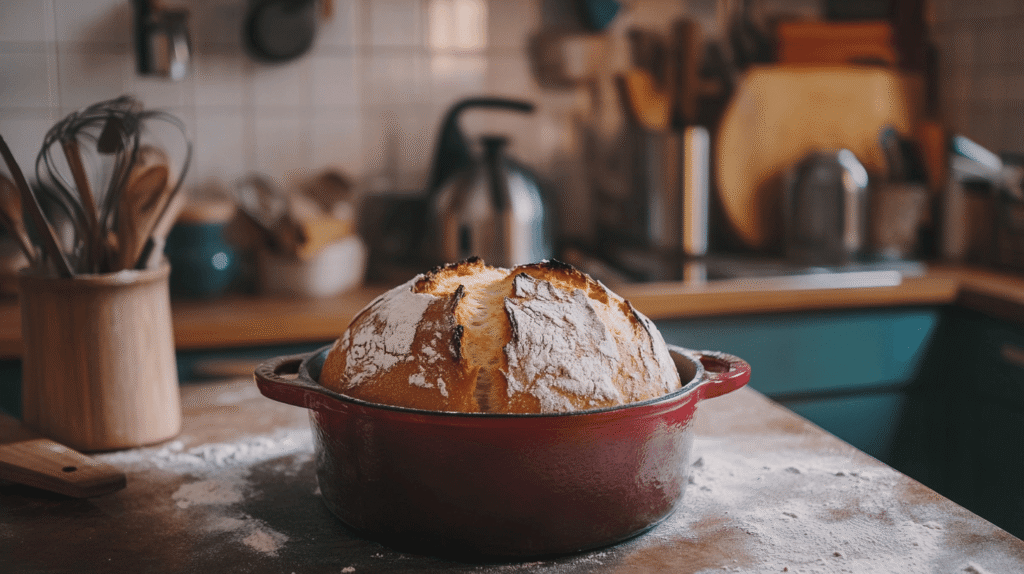Baking sourdough at home? A Dutch oven is essential for creating a perfect crust and fluffy interior. But what size Dutch oven for sourdough is ideal? Choosing the right size ensures even baking, proper steam retention, and the best results. This guide will help you find the perfect Dutch oven for your baking needs.
We’ll break down everything you need to know about picking the right Dutch oven for sourdough from size and shape to materials and expert tips.
Table of Contents
Why a Dutch Oven is Perfect for Sourdough
- Creates Steam for a Perfect Crust: The lid traps moisture, helping develop that crispy, caramelized crust.
- Retains Heat Effectively: Ensures consistent baking, promoting a perfect rise.
- Consistent Baking Temperature: Thick walls trap heat for a stable baking environment.
Key Factors When Choosing the Right Size Dutch Oven for Sourdough

1. Bread Size and Recipe Requirements
- Small Loaves (Up to 1 lb): 3–4 quart Dutch oven.
- Standard Loaves (1.5–2 lbs): 5–6 quart Dutch oven (most popular).
- Large Loaves (2.5+ lbs): 7+ quart Dutch oven.
2. Shape: Round vs. Oval
- Round: Best for boule-style (round) loaves.
- Oval: Ideal for batards (oval-shaped loaves).
3. Material and Thickness
- Bare Cast Iron: Best heat retention, but needs seasoning.
- Enameled Cast Iron: Easier to clean, rust-resistant, and colorful.
4. Lid Design and Sealing Ability
Look for a heavy, tight-fitting lid to trap steam properly.
5. Weight and Portability
Choose a size that’s easy to handle, especially when hot.
Common Dutch Oven Sizes for Sourdough Baking
| Size | Ideal For | Pros | Cons |
|---|---|---|---|
| 3–4 quarts | Small loaves | Lightweight, quick to preheat | Limited space for dough |
| 5–6 quarts | Standard loaves | Versatile, easy to handle | Slightly large for tiny loaves |
| 7+ quarts | Large loaves, batches | Roomy, flexible | Heavy, longer to preheat |
Recommended Dutch Oven Size for Sourdough Bakers
For most bakers, 5–6 quarts is the perfect size:
- Fits standard recipes.
- Allows dough expansion without crowding.
- Balances weight, heat distribution, and practicality.
Best Brands in This Range:
- Lodge: Affordable and durable.
- Le Creuset: Premium quality and colorful.
- Staub: Excellent heat retention and tight-sealing lid.
Shape Matters: Round vs. Oval Dutch Ovens

| Shape | Best For | Notes |
|---|---|---|
| Round | Boule loaves | Most versatile for beginners. |
| Oval | Batards | Great for more experienced bakers experimenting with shape. |
Materials and Features to Consider
- Enameled Cast Iron: Easiest to maintain and clean.
- Bare Cast Iron: Best for traditionalists who don’t mind seasoning.
- Tight-Fitting Lid: Essential for trapping steam and creating a superior crust.
Adjusting Based on Recipe Size
- Larger Loaves (3+ lbs): Use 7-quart or bigger.
- Mini Loaves: Use 3–4 quarts to concentrate heat and steam effectively.
How to Measure Your Dutch Oven for Sourdough
- Diameter: Measure the widest point inside the Dutch oven.
- Depth: Measure from base to lid (internally).
- Fit Tip: Leave at least 1–2 inches clearance above the dough for rising.
Expert Tips for Baking Sourdough in a Dutch Oven
- Always Preheat: 450°F (232°C) with the Dutch oven inside for at least 30 minutes.
- Use Parchment Paper: For easier dough transfer and to prevent sticking.
- Remove Lid Midway: After 20–30 minutes to crisp up the crust.
- Hydrate the Dough Well: More hydration = more steam = better crust.
- Spritz if Needed: Lightly mist dough if extra steam is necessary.
Dutch Oven Alternatives for Sourdough Baking
- Baking Stone/Steel + Steam Pan
- Bread Cloche: Designed for artisan bread.
- Oven-Safe Stock Pots or Roasters
- Upside-Down Bowl Method: Trap steam with an inverted bowl.
FAQs
Can I bake sourdough without a Dutch oven?
Yes! Use a stone, cloche, or stock pot with steam.
What is the minimum Dutch oven size for sourdough?
A 4-quart pot works for small loaves, but 5–6 quarts is best for flexibility.
Are oval Dutch ovens better than round ones?
Depends on loaf shape. Round for boules, oval for batards.
Do I need to preheat the Dutch oven?
Yes! Preheating is crucial for oven spring and crust formation.
Can I use a Dutch oven for other breads?
Absolutely! Rye, whole wheat, brioche you name it.
Conclusion
Choosing the right Dutch oven size is key to sourdough success. For most home bakers, a 5–6 quart round Dutch oven is the sweet spot for achieving beautiful, bakery-quality loaves.
Experiment with different shapes, sizes, and materials to find your perfect match. Happy baking!
Experiment with different shapes, sizes, and materials to find what works best for you. For a comprehensive guide to using your Dutch oven for soups, bread, and more, visit our ultimate guide to Dutch oven recipes. The journey of sourdough baking is as rewarding as the results happy baking!

